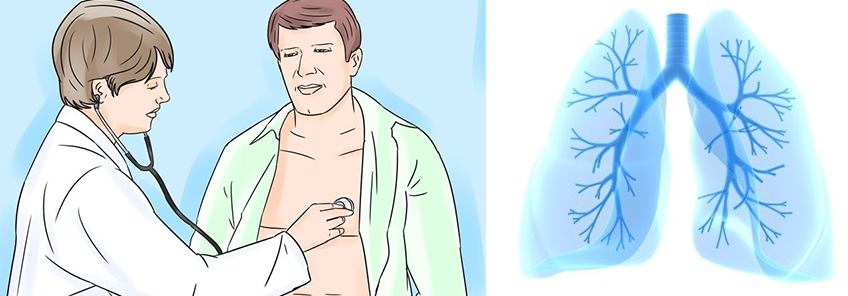Tuberculosis

- Latent TB: Once infected with tuberculosis bacteria, one is never cured of it. Most of the time it lies dormant in the lungs without causing any symptoms and is called latent TB. The risk of reactivation increases when body’s immune system goes down. Latent TB needs to be treated, even in absence of symptoms, to prevent the risk of full blown active tuberculosis later. It is treated with isoniazid for six months. TB is not transmissible at this stage.
- Active tuberculosis: This is when you develop signs and symptoms of tuberculosis. This may follow immediately after the first exposure without going into the latent phase or it can develop many years later after the first mildly symptomatic primary infection goes into dormancy. You can spread the disease during this stage.
- cough for more than two weeks
- streaks of blood in cough
- low grade fever in da
- night sweats
- chest pain
- unexplained weight loss
- pallor (anemia)
- anorexia; malaise with general weakness and other associated features
- Age: children and elderly are more at risk of infection
- People with low immunity such as HIV/AIDS, cancer, etc.
- First-generation immigrants from high-prevalence countries
- Close contacts of patients with smear-positive pulmonary tuberculosis
- Overcrowded environments like prisons, collective dormitories
- Cough for more than two weeks
- Blood in sputum/hemoptysis
- Unexplained weight loss
- Cough with chest pain
- Continuous low grade fever for more than a week
- Combination packs of isoniazid, rifampicin, pyrazinamide, ethambutol are used. Injections of streptomycin may also be used where appropriate.
- The needed combination is decided after thorough medical checkup.
- Treatment duration, although called short course in the program name, extend between six to twelve months or more according to the type of TB.
- Once diagnosed with active pulmonary tuberculosis, start treatment and use a mask to prevent transmission of disease to others. Disease transmission decreases after about two weeks of starting the treatment.
- Drug combinations should be strictly followed as prescription; otherwise there is risk of drug resistant tuberculosis. DOTS strategy uses directly observed treatment in which a near member of the family watches the patient swallow medications regularly.
- BCG vaccination is given to infants by Nepal Government to protect from tuberculosis.
- WHO recommends proper nutrition to make up for the losses and also to decrease the risk factors for tuberculosis. Maintain optimum nutritional status of the body so that loss of immunity is prevented.
- massive haemoptysis (coughing of blood)
- cor-pulmonale (heart disease due to lungs disease)
- atypical mycobacterial infection
- aspergilloma
- lung/pleural calcification which can be seen in chest x-rays
- bronchiectasis
- bronchopleural fistula (opening between airway and pleural covering of lungs
Tuberculosis (TB) is a communicable disease caused by Mycobacterium tuberculosis. It can affect any organ in the body but lungs (Pulmonary TB) are the most common site of infection. Other common sites of infection are bones, lymph nodes, kidneys, uterus, brain (meninges), skin, etc.
Tuberculosis is transmitted from one person to another by inhalation of droplets released into the air by an infected person when they sneeze or cough. Transmission is high in crowded area with high humidity. Entry of bacteria into the lungs causes mild illness called primary tuberculosis. Usually it doesn’t lead to significant disease and resolves after body’s immune system traps and localises the organism into a small area in the lung called ghon’s focus where it remains dormant for long period. Later, when body defenses become weak, these dormant bacteria reactivate and cause significant disease called secondary tuberculosis. Most of the tuberculosis in adults are reactivation tuberculosis. A large proportion of population in developing countries have been exposed to TB and have dormant bacteria in the lungs and are at risk of reactivation tuberculosis. Tuberculosis had become a rare disease in developing countries but its prevalence is increasing after HIV/AIDS became common.
Natural course of Tuberculosis
There are two stages of tuberculosis
Symptoms of active Tuberculosis
Here are some of the symptoms of active tuberculosis:
Common Causes/ Risk Factors
Causative agent of tuberculosis is Mycobacterium Tuberculosis in most of the cases. Other bacteria are Mycobacterium Bovis and Mycobacterium Africanum. Following conditions increase the risk of acquiring tuberculosis:
Red Flag Signs/ When to seek Care
Treatment Options
Active tuberculosis is diagnosed by the presence of abnormal chest xray in patient with risk factors who have above mentioned symptoms. When microscopic examination of sputum shows tuberculosis germ, it is called smear positive TB and is highly infectious. Even if not seen under microscope, the bacilli can grow in culture medium. It is then called culture positive TB. When bacilli is not seen under microscope and doesn’t grow in culture it is called culture negative and is less contagious.
Latent TB is diagnosed by skin test called PPD test or a blood test called Quantiferon test.
Both latent TB and active TB need to be treated. Latent TB needs treatment with a single drug for six months while active TB needs to be treated with a combination of drugs (3 -4) for 6-9 months. Completion of required dose and duration is essential for cure and to prevent emergence of drug resistant tuberculosis which are called multidrug resistant Tb (MDR) or extended drug resistance TB (XDR) and are very difficult to treat.
Anti-tubercular drugs are distributed free by government of Nepal under DOTS (directly observed treatment short course) program.
Complications of Tuberculosis



Send us your feedback on this article